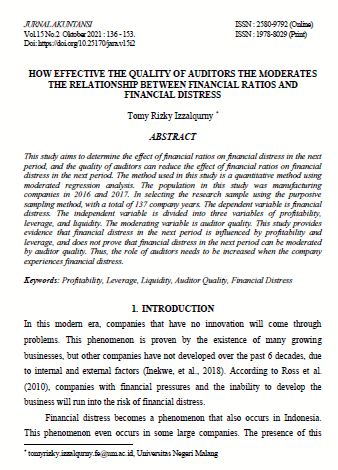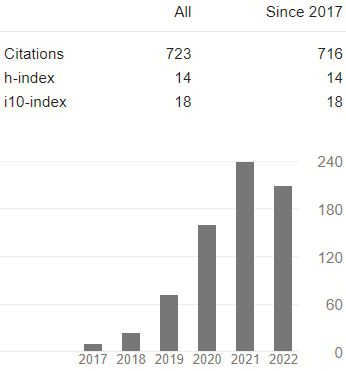How Effective The Quality of Auditors the Moderates The Relationship Between Financial Ratios and Financial Distress
DOI:
https://doi.org/10.25170/jak.v15i2.2242Keywords:
profitability, leverage, liquidity, auditor quality, financial distressAbstract
This study aims to find out the influence of financial ratios toward financial distress in the further period, and the quality of auditors can reduce the influence of low financial ratios toward financial distress in the further period. The population of this study is manufacturing companies that have reviewed the 2016 and 2017 financial statements.In the selection of research samples using a purposive sampling method, in the order, the research sample numbered 137 firm years. The dependent variable is financial distress. Independent variables are divided into three variables of profitability, leverage, and liquidity. The moderating variable is the quality of the auditor. In this study hypothesis testing using the moderated regression analysis (MRA) model which includes using a tiered regression analysis method. This study provides evidence that the financial distress in the next period is influenced by profitability and leverage, and not prove that financial distress in the next period could be moderated by the quality of auditors.
References
Alifiaha, M., Salamudi, N., & Ahmad, I. (2013). Prediction of Financial Distress Companies in the Consumer Products Sector in Malaysia. Jurnal Teknologi, 64(1).
Amanah, R., Atmanto, D., & Azizah, D. (2014). Pengaruh Rasio Likuiditas dan Rasio Profitabilitas terhadap Harga Saham (Studi pada Perusahaan Indeks LQ45 Periode 20082012). Jurnal Administrasi Bisnis, 12(1), 110.
Chen, R., Chidambaran, N., Imerman, M., & Sopranzetti, B. (2014). Structural Analysis of Financial Institutions in Crisis. Journal of Banking and Finance, 168.
Chiaramonte, L., & B, C. (2016). Capital and Liquidity Ratios and Financial Distress Evidence from The European Banking Industry. The British Accounting Review, 150.
D'Mell, L., & Sivaprasad, S. (2015). An Investment Strategy Based on Leverage: Evidence from BSE 500. Journal of Emerging Market Finance, 14(3), 210238.
Durrah, O., Rahman, A., Jamil, S., & Ghafeer, N. (2014). Exploring the Relationship between Liquidity Ratios and Indicators of Financial Performance: An Analytical Study on Food Industrial Companies Listed in Amman Bursa. International Journal of Economics and Financial Issues, 6(2), 435441.
Dwijayanti, S. (2010). Penyebab, Dampak dan Prediksi dari Financial Distress serta Solusi untuk Mengatasi Financial Distress. Jurnal Akuntansi Kontemporer, 2(2), 191205.
Husna, H., & Rahman, R. (2012). Financial Distress-Detection Model for Islamic Banks. International Journal of Trade, Economics, and Finance, 3(3), 158162.
Ilmi, A., & Norita, F. A. (2016). Analisis Financial Distress dengan Menggunakan Metode Altman, Ohlson dan Fulmer untuk Memprediksi Kebangkrutan Serta Kesesuaian dengan Opini Auditor (Studi pada Perusahaan Sektor Pertambangan Batu Bara yang Terdaftar di Bursa Efek Indonesia Tahun 2009201. Jurnal IlmuIlmu Sosial dan Humaniora, 18(2), 1120.
Imelda, E., & Alodia, C. (2017). The Analysis of Altman Model and Ohlson Model In Predicting Financial Dsitress of Manufacturing Companies in the Indonesia Stock Exchange. IndianPacific Journal of Accounting and Finance, 1(1), 5163.
Inekwe, J., Jin, Y., & Valenzuela, M. (2018). The effects of financial distress: Evidence from US GDP growth. Economic Modelling, 72, 821.
Kordestani, G., Bilglari, V., & Bakhtiari, M. (2011). Ability of Combinations of Cash Flow Components to Predict Financial Distress. Teorija ir Praktika Business, 12(3), 277285.
Kristanti, F., Rahayu, S., & Huda, A. (2016). The Determinant of Financial Distress on Indonesian Family Firm. Procedia Social and Behavioral Sciences, 440447.
Liana, L. (2009). Penggunaan MRA dengan Spss untuk Menguji Pengaruh Variabel Moderating terhadap Hubungan antara Variabel Independen dan Variabel Dependen. Jurnal Teknologi Informasi, 14(2), 9097.
Meeampol, S., Lerskullawat, P., Wongsorntham, A., Srinammuang, P., Rodpetch, V., & Noonoi, R. (n.d.). Applying Emerging Market ZScore Model To Predict Bankruptcy: A Case Study Of Listed Companies In The Stock Exchange Of Thailand (SET)., (pp. 2271237).
Muzir, E., & Caglar, N. (2009). The Accuracy of Financial Distress Prediction Models in Turkey: A Comparative Investigation With Simple Model Proposals. 9(2), 1548.
Ningrum, D. (2019, June 12). 4 Perusahaan Besar Mendadak Bangkrut Ini Penyebabnya. Retrieved from Merdeka: https://www.merdeka.com/uang/4perusahaanbesarmendadakbangkrutinipenyebabnya.html
Putri, N., & Merkusiwati, N. (2014). Pengaruh Mekanisme Corporate Governance, Likuiditas, Levarge, dan Ukuran Perusahaan pada Financial Distress. Jurnal Akuntasi universitas Udayana, 7(1), 93106.
Ross, A., Westerfirld, R., & Jordan, B. (2010). Corporate Finance Fundamentals. New York: McGrawHill.
Ross, S. (1977). The Determination of Financial Structure: The IncentiveSignalling Approach. The Bell Journal of Economics, 8(1), 2340.
Salloum, C., Azzi, G., & Gebrayel, E. (2014). Audit Committee and Financial Distress in the Middle East Context:Evidence of the Lebanese Financial Institutions. International Strategic Management Review, 2, 3945.
Setiawan, I., & Widyawati, D. (2014). Faktorfaktor yang Mempegaruhi Tingkat Ketepatan Waktu Pelaporan Keuangan Perusahaan Manufatur di Indonesia. Jurnal Ilmu dan Riset Akuntansi, 3(9), 117.
Skinner, D., & Srinivasan, S. (2012). Audit Quality and Auditor Reputation: Evidence from Japan. The Acconting Review, 87(5), 17371765.
Susilowati, Y., & Turyanto, T. (2011). Reaksi Sinyal Rasio Profitabilias dan Rasio Solvabilitas terhadap Return Saham Perusahaan. Jurnal Dinamika Keuangan dan Perbankan, 3, 1727.
Van Horne, J., & Warchowich, J. (2005). Prinsipprinsip Manajemen Keuangan Edisi Kedua Belas. Jakarta: Salemba Empat.
Wolk, H., & Tearney, M. (1997). Accounting Theory: A Conceptual and Institutional Approach. Fourth edition. London: International Thomson Publishing.

Downloads
Published
Issue
Section
License
Authors who publish with this journal agree to the following terms:
- Authors retain copyright and grant the journal right of first publication with the work simultaneously licensed under a Creative Commons Attribution-ShareAlike 4.0 International License that allows others to share the work with an acknowledgment of the work's authorship and initial publication in this journal.
- Authors are able to enter into separate, additional contractual arrangements for the non-exclusive distribution of the journal's published version of the work (e.g., post it to an institutional repository or publish it in a book), with an acknowledgment of its initial publication in this journal.
- Authors are permitted and encouraged to post their work online (e.g., in institutional repositories or on their website) prior to and during the submission process, as it can lead to productive exchanges, as well as earlier and greater citation of published work.














